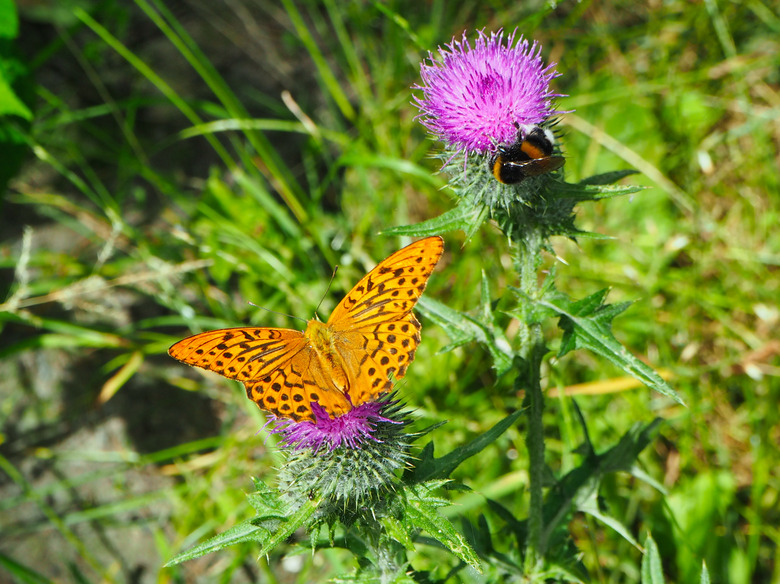What Insects Lay Eggs?
Like fish, reptiles and birds, almost all female insects are oviparous, meaning they lay eggs. While some egg-laying animals have nurturing instincts, tending carefully to their eggs and making sure that they are warm and protected, most insects do not display these behaviors. They simply deposit their eggs on or near a food source and then move on. A few insect groups however, are exceptions to the typical oviparity.
Insect Life Cycle
Insect Life Cycle
Insects grow by a series of molts, shedding their hard outer surface called an exoskeleton. With each molt, the body changes in some way. This change in form is known as metamorphosis. Most insects go through complete metamorphosis, which includes four distinct stages of development: egg, larva, pupa and adult.
The egg hatches into a wormlike larva that molts up to several times depending on the species. The well-known larva of a butterfly or moth is a caterpillar, while the larva of a beetle is sometimes called a grub. Once the larva has molted for the last time, it changes into an inactive, resting pupa (in butterflies this is called a chrysalis while moths pupate in a cocoon). The pupa then changes into the adult insect. Adult, female, oviparous insects mate and lay eggs, and the cycle begins again.
Insects such a grasshoppers, crickets and earwigs go through simple metamorphosis where the wings develop externally and there is no real resting stage before becoming an adult. With simple metamorphosis, the immature insects often look very similar to the adults.
Oviparity in Insects
Oviparity in Insects
Oviparity is common in most insect groups including dragonflies, grasshoppers, wasps, bees, beetles, ants and butterflies. Some of these even have modified abdominal appendages, known as ovipositors, for the purpose of depositing their eggs in specific places. The parasitic ichneumon wasp, for example, has an ovipositor more than twice its body length. It uses this for drilling through wood and depositing eggs into the larva of another insect species that hides in the wood.
Ovipositors of some Hymenoptera (the group that includes wasps, bees and ants) have developed to sting rather than lay eggs.
Some insects, like termites, may just drop their eggs anywhere, while others, like monarch butterflies, are careful to lay their eggs on the underside of milkweed leaves. When the eggs hatch, the immature larvae can feed on that milkweed.
Viviparity in Insects
Viviparity in Insects
The incubation and development of eggs within the mother is not common in insects. This process, known as viviparity, can take different forms. Some cockroaches, beetles and flies incubate the fertilized eggs within the female and give birth to live young. This is known as ovoviviparity. Other forms of viviparity, where the mother transfers nutrients to the developing embryos through internal tissue, occur in some aphids, earwigs and a few other species.
Unfertilized Insect Eggs
Unfertilized Insect Eggs
Reproduction in most oviparous creatures involves the mating of males and females, with the male fertilizing the eggs with its sperm.
Read more about how insects reproduce asexually.
Many insects have evolved, either due to scarcity of males or environmental conditions, to produce offspring without the requirement of mating with a male. This parthenogenesis occurs in species of aphid, stick insect, cockroach and Hymenoptera. Honeybees produce both fertilized and unfertilized eggs. The fertilized insect eggs develop into female worker bees while the unfertilized male drones are responsible for leaving the colony to find other queen bees for mating.
Those new queens will lay both fertilized and unfertilized eggs in their own colony.
References
- Carlton College Cowling Arboretum: Drilling in the Arboretum: The Life and Times of an Ichneumon Wasp
- University of Minnesota Monarch Lab: Monarch Life Cycle
- University of Kentucky: Recognizing Insect Larval Types
- Arizona State University: Ask a Biologist: Colony Life of a Honey Bee
- North Carolina State University: Survival Strategies
Cite This Article
MLA
Godawa, Jean. "What Insects Lay Eggs?" sciencing.com, https://www.sciencing.com/insects-lay-eggs-8455645/. 22 November 2019.
APA
Godawa, Jean. (2019, November 22). What Insects Lay Eggs?. sciencing.com. Retrieved from https://www.sciencing.com/insects-lay-eggs-8455645/
Chicago
Godawa, Jean. What Insects Lay Eggs? last modified March 24, 2022. https://www.sciencing.com/insects-lay-eggs-8455645/
